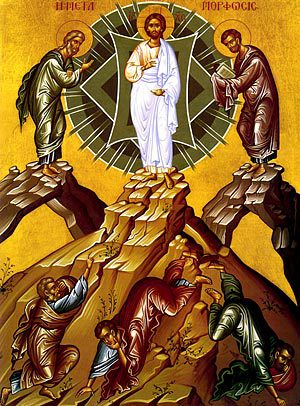The Symbolic Meaning Of The Transfiguration
For Western Christians and Orthodox who follow the New Calendar (that is, most American Orthodox, but not us Old Calendar people), today is the feast of the Transfiguration of Christ. Here, from Matthew 17, is the event Christians commemorate:
After six days Jesus took with him Peter, James and John the brother of James, and led them up a high mountain by themselves. There he was transfigured before them. His face shone like the sun, and his clothes became as white as the light. Just then there appeared before them Moses and Elijah, talking with Jesus.
Peter said to Jesus, “Lord, it is good for us to be here. If you wish, I will put up three shelters—one for you, one for Moses and one for Elijah.”
While he was still speaking, a bright cloud covered them, and a voice from the cloud said, “This is my Son, whom I love; with him I am well pleased.”
When the disciples heard this, they fell facedown to the ground, terrified. But Jesus came and touched them. “Get up,” he said. “Don’t be afraid.” When they looked up, they saw no one except Jesus.
If you’ve been following this blog for a time, you may not be surprised to learn that this is my favorite of all Jesus’s miracles. It appeals to my inner Platonist. In this moment, the disciples were allowed to see things as they really are, the reality that is ordinarily veiled by the material. At First Things, Dale Coulter has a lovely short reflection on the meaning of the Transfiguration:
The glory of Christ on Mount Tabor embodies a joy that is unspeakable. In order words, the transformation of human affections impacts bodily states, causing a change in countenance. There is a radiance on the face of the joyous that pulls out the beauty of the divine image, which lays buried underneath the veils of the passions. If holiness concerns reintegrated and redirected emotion and desire so that perfect love reigns in the heart, then it creates a joy that alters human existence. The transfiguration symbolizes the Psalmist’s admonition to taste the Lord and see that he is good. Every moment of joy is but a foretaste of that deeper bliss, and it breaks through in serendipitous ways as C. S. Lewis discovered.
The transfiguration, then, symbolizes the life to come and thus the goal of ascetic pursuit. It reminds the believer that the vision of God unfolds amidst the splendor of holiness while also pointing toward the way in which the final movement to ecstatic wonder is always grace-filled and joy-laden. It is the sudden burst of divine light as when Helios peaks over the horizon casting his rays on all creation so that the world glows in the golden haze of dawn, translucent and transformed.
For me, every point of conversion has been because of a moment of Transfiguration: when I saw the world as it truly is, under God, and had my inner vision changed by that revelation. For example, my sister’s wake at the Methodist Church, seeing all those people of my town there to show love and respect for her and my family, was a transfiguration moment for me. It’s when all the intuitions that had been building within me over the course of Ruthie’s cancer journey came to a head in that one moment in time, and I saw that things that had before seemed ordinary to me were in fact concealing the presence of God, and His work in the world. My wife saw it too, and that’s why we decided to move here.
Here is the style of Transfiguration icon we have in our parish:
Notice the symbolism here. The figure of Jesus is inside a circle, symbolizing wholeness, completeness, infinity. Within the circle is a square, the traditional symbol of the earth, or mortality. Closest to the figure of Christ is a rectangle with sides bending towards Christ, symbolizing that in Christ, the circle is squared — that is, the paradoxical unity of matter and spirit, of the temporal and the eternal, of the finite and the infinite, has been accomplished. It is impossible to square a circle, of course — and the symbolism of this icon is revealing to us the nature of the Transfiguration miracle.
There is much more to the symbolism of this icon. The Irish Anglican priest Fr. Patrick Comerford has a wonderful blog post explaining the theological significance of the Transfiguration, and interpreting the symbolism in various Transfiguration icons.
Another common symbol used in Transfiguration icons has Christ appearing within an oval vesica piscis, or mandorla. Icon Reader has a discussion of the recurrence of the mandorla in Orthodox iconography, including of the Transfiguration; one of the oldest manifestations of this is in a sixth-century mosaic inside the St. Catherine’s monastery. This symbol is what you get when two circles overlap; it reveals to us that in Christ, heaven and earth meet, and are united. The mandorla is not a Christian symbol alone; it was present in sacred geometry before Christ, as was the mandala.
The mandorla is ubiquitous in medieval churches of the West; here, for example, on the western facade of the Chartres cathedral, is an image of Christ Pantokrator (Ruler Of The Cosmos) within a mandorla.
(I was pleased and surprised to discover when I returned to the Chartres cathedral in 2012 after not having seen it for many years that learning how to read icons as an Orthodox Christian opened up the medieval Catholic cathedral to me at a level I had not previously been able to perceive. The entire cathedral is a three-dimensional icon, and icons within an icon. A medieval peasant who was illiterate may nevertheless have been capable of “reading” the iconography in the cathedral.)
As the Orthodox priest Father Stephen Freeman put it in a short piece about the mandorla in Christian iconography:
The Fathers taught us: “Icons do with color what Scripture does with words.” The iconic grammar of the mandorla, points us to the great mysteries made known to us in Scripture and make it clear that such mysteries may be known and entered into.

